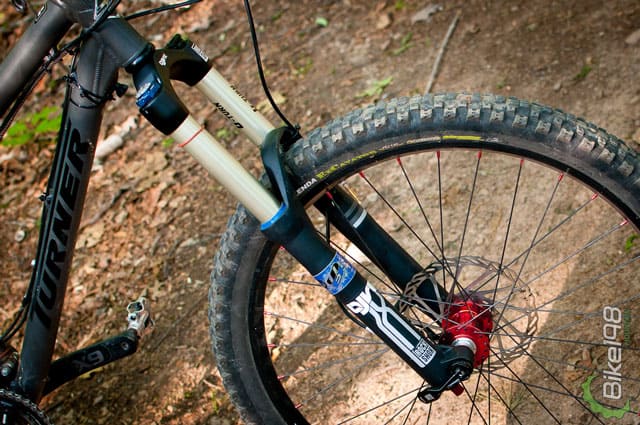Modern mountain bike suspensions have a lot of little adjustments that can make really dialing in your bike a daunting task for those riders that are not used to setting up a bike. With air pressures, damping control, rebound adjustments and travel changes, there are a lot of factors that effect each other on your bike.
Most riders rarely ever look at the adjustments they have available on their suspension components. Many bikes are left with the settings they had on the showroom floor which means you could be giving up better traction, control and more speed on the trail. These are not that hard to dial in as long as you take a few necessary steps to insure you are getting the proper setup.
Step 1: Sag on Rear Suspension
How much sag you want to run (the amount your suspension compresses from just sitting on the bike) is largely dependent upon the type of bike you are riding and the style of riding you call home.
As a general rule, the more XC oriented your bike is…the less sag you will run. If you are riding a 29er cross country bike or a bike in the 130mm rear wheel travel range, you are going to run between 20% and 25% sag. To measure the sag, push the o-ring on the shock to the top and sit on the bike being careful not to press down on the suspension with more than just your body weight. When you measure how far the o-ring went down, that should equal 25% of the stroke.
A great starting point is to fill the pressure in the shock to your riding weight in psi or go by the manufacturers recommendation adjusting from there. If you are on a bike that has 140mm or more of travel, you will be looking for 35% or greater sag to make better use of the travel. This initial setting is going to give you the starting point for on trail testing.
Step 2: Set Initial Pressures on Front Suspension
What we have found across most suspension manufacturers is that the recommended pressures for suspension forks is too stiff for regular riding. It does give you an idea on where to start so you can then adjust on the trail to get everything dialed in the way you want. With differences in geometry and the way you sit on a bike, it is hard to go by any typical sag measurements on forks.
Step 3: Find a Section of Trail You Know Very Well
For the rest of the setup procedure, you really need a section of trail that you know like the back of your hand. This section of trail also needs to have varying characteristics to it such as roots, rocks, downhill and climbing. This is easiest to tune when the trail is in a confined area that can be looped multiple times very easily.
This video is the downhill section of my testing and tuning grounds that has a steep climb to get back to the top. It is the best of both worlds that allows me to feel the bike without having to worry about the trail as I can basically ride it in my sleep. that makes it perfect for suspension tuning. I can get in about 8 rounds before my legs start to really feel the climbing.
Dial In Your Suspension
As mentioned before, all of your suspension components and adjustments work together on the bike. The ideal setup allows you to use all of your travel without bottoming out hard on big hits. It also allows for the suspension to suck up small and large bumps while still keeping efficiency for pedaling and climbing. So…let’s run through how the bike should feel…
Not Using All of Your Travel – Air pressure adjustment. Let out about 5 to 10 psi at a time until you are comfortable with the amount of travel you are using under hard hits. If you have a small ledge or successive hard rock hits, that is perfect to try to get worst case scenario on the trail.
Going Through Travel Too Easily – Add more pressure. Basically the opposite of above. The bike will feel really mushy and too plush.
Rear End Is Bouncing You Out of the Seat After Compression – Check your rebound setting. If it is set too fast (typically counterclockwise on a dial), the suspension is trying to recover too quickly from a hit thus springing the bike upward. If you have your air pressures dialed, you should not feel like every rock and root eventually kicks the rear end of the bike up. One thing to keep in mind…having too little or too much air in your tires can also cause this feeling on the bike.
Rear End Feels Dead and Seems to Sink – When you have rebound too slow (turned clockwise), the shock can not recover fast enough so it ends up packing up. It starts to sink farther into the travel over time eventually staying in the bottom portion when you are getting successive hits. By turning the dial counterclockwise, you speed that recovery up to you are in more of your usable travel. If you make it too fast, you get the feeling above.
The same goes for front suspension as the rear. You want to use all available travel without harsh bottom outs. The o-ring on the stanchion is a great indicator on how the suspension is performing in terms of air pressure. The rest of the settings (typically just rebound as the others are in relation to lockout mainly) will be adjusted according to feel on the trail.
As a good rule of thumb, if you really want to see how adjustments effect suspension, get your air pressure dialed then try each of the extremes of rebound. This will let you feel how the bike reacts under each extreme so you can then start to dial it back and forth to get the optimal setting for your bike and riding style.
If you have any questions on your particular setup and issues, hit up this thread and we will answer your questions to get you the perfect setup.

